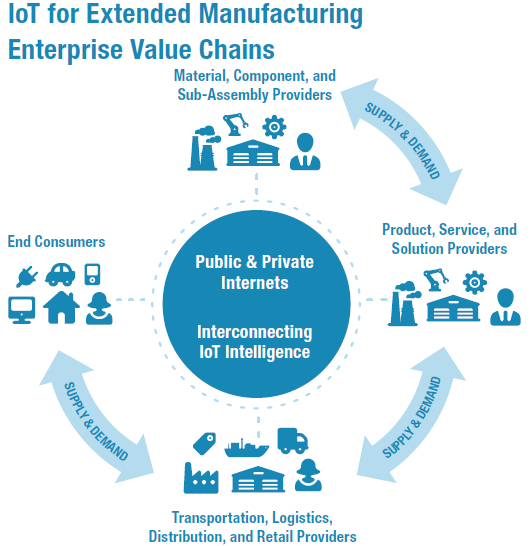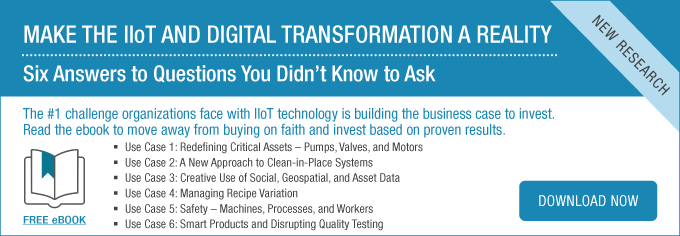 In a previous article we discussed findings from a recent LNS survey and revealed that 43% of manufacturing professionals don’t understand the IoT. A concerning, but not surprising result. There’s something important lurking behind the fact that most have heard of the ubiquitous term–it is hard not to have. And yet minimal understanding by a significant number of quality executives persists and therefore there’s less active pursuit of the potential fruit it yields, other than by innovators, for now at least.
In a previous article we discussed findings from a recent LNS survey and revealed that 43% of manufacturing professionals don’t understand the IoT. A concerning, but not surprising result. There’s something important lurking behind the fact that most have heard of the ubiquitous term–it is hard not to have. And yet minimal understanding by a significant number of quality executives persists and therefore there’s less active pursuit of the potential fruit it yields, other than by innovators, for now at least.
In this post we intend to take the discussion to the next logical stage, beyond the smart manufacturing plant and over and above servitization—both of which are very important topics and warrant our attention. But we also need to examine the practical challenge that manufacturers face based on the assumption that more information is a good thing. With that challenge, executives are becoming hard-pressed to answer the following:
-
What is in store for the quality management closed loop when the information bombardment begins?
-
How do we prepare for the vast pipeline or stream of potentially actionable data returning to the organization?
When the DRIP Becomes a Flood?
From laggards to leaders, many organizations fail to truly exploit all the data they have available today. Yet galloping towards us is the promised explosion from big data and the potential offered by the insight revolution. What quality management has to gain from IoT is the most formidable closed feedback loop leap to date.
The reality of connected, smart products will deliver concrete, objective and potentially continuous use, performance and reliability data. There is realistic potential that the overhead of complaints could shrink to a minimal and occasional blip. Thus eliminating in many cases the huge overhead of a traditional investigation for a field failure or if the predictions are accurate, preventing them before they occur.
The challenge, though, will be that organizations already have more information than they know what to do with. Most are facing significant challenges already with regard to being Data Rich–Intelligence Poor ("DRIPs," so to speak). The most adept are those organizations with an architecture conducive to managing pre-architected closed-loop quality processes across the value chain. The very chain that will be the recipient of this feedback boost.
The organizations that have already deployed and embedded enterprise quality management software (EQMS) either by expanding on ERP, PLM, MOM, or deploying a dedicated quality hub platform still have work to do but they are significantly better placed than those without. Many have utilized the right metrics to measure quality or are on the right path but the next wave is something entirely different than the health and performance of the QMS. The next wave is actionable data direct from the product in the field.
The New Intelligence Paradigm
The question being asked by every organization with awareness and understanding of IoT today is how will we capture, process and derive meaningful intelligence from this stream? This is reasonable as there will be significant volume looping back but this is not big data per se since it is not unstructured--quite the opposite. The incoming stream is by design and is therefore structured originally by us, the OEM. The real question is how do we take the stream and drive accurate and meaningful outcome in the form of improvement?
 The answer is to approach the IoT with the mindset that it will supercharge the quality management system by tightening the closed-loop approach so that engineering is more closely connected with the rest of the value-chain than ever before. Improvement action or CAPA as we know it today becomes the vehicle for designing for quality based on the new channel of intelligence. Agility will be an explicit requirement of this new dawn and building a strategy or laying the foundation for the advent is critical to success.
The answer is to approach the IoT with the mindset that it will supercharge the quality management system by tightening the closed-loop approach so that engineering is more closely connected with the rest of the value-chain than ever before. Improvement action or CAPA as we know it today becomes the vehicle for designing for quality based on the new channel of intelligence. Agility will be an explicit requirement of this new dawn and building a strategy or laying the foundation for the advent is critical to success.
The opportunities in IoT are accompanied by some level of threat too. There are some privacy and security issues with regard to smart connected products and the data relating to performance and use--analogous to location services and other ‘personal’ information freely shared with application providers by the 1.75billion smartphone owners globally. Feedback can be used (and therefore misused) for derived as well as literal intelligence. It will be important to articulate the value and terms of use of the data (in the context of product monitoring and improvement). Specifically, using data for improvement and demonstrating openly that such data is captured and managed in a harmonized, traceable, secure and accountably driven EQMS is a reasonable proposition.
Assess Your Current State
IoT will increase the amount of data coming from internet-enabled manufacturing processes, manufacturing workers, manufacturing assets, components, finished products, and customers. If all of this data is to be used intelligently (i.e. to become proactive instead of reactive) it has to be collected by a single system with harmonized processes and the insights have to be driven back upstream for improved product and process design. This cannot be established when a company has multiple CAPA systems for (i.e. engineering, manufacturing, and the field have separate systems) and when engineering is not connected to the results of the CAPA process.
Being prepared includes assessment of the current capability of the QMS. Does the infrastructure already creak under the weight of manual processes? Does the traditional interface between departments exist as a silo? If so, this is likely to cause a buckling scenario as new demands become our new reality. Connected and smart products will demand that our quality management processes mature and are better connected and key to this is tracking the actionable content derived from the ubiquitous product cloud. Get ready or it’s possible you may be left behind.
